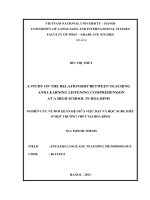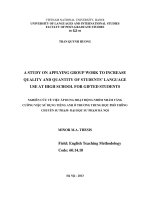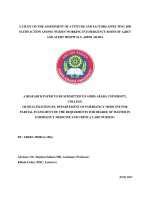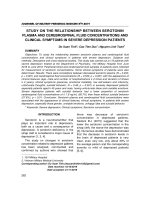A study on the relationship between teaching and learning listening comprehension at a high school in Hoa Binh = Nghiên cứu về mối quan hệ giữa việc dạy và học
Bạn đang xem bản rút gọn của tài liệu. Xem và tải ngay bản đầy đủ của tài liệu tại đây (1.6 MB, 96 trang )
VIETNAM NATIONAL UNIVERSITY – HANOI
UNIVERSITY OF LANGUAGES AND INTERNATIONAL STUDIES
FACULTY OF POST – GRADUATE STUDIES
BÙI THỊ THỦY
A STUDY ON THE RELATIONSHIP BETWEEN TEACHING
AND LEARNING LISTENING COMPREHENSION
AT A HIGH SCHOOL IN HOA BINH
NGHIÊN CỨU VỀ MỐI QUAN HỆ GIỮA VIỆC DẠY VÀ HỌC NGHE HIỂU
Ở MỘT TRƯỜNG THPT TẠI HÒA BÌNH
M.A MINOR THESIS
FIELD : ENGLISH LANGUAGE TEACHING METHODOLOGY
CODE : 60.14.0111
HANOI – 2013
VIETNAM NATIONAL UNIVERSITY – HANOI
UNIVERSITY OF LANGUAGES AND INTERNATIONAL STUDIES
FACULTY OF POST – GRADUATE STUDIES
BÙI THỊ THỦY
A STUDY ON THE RELATIONSHIP BETWEEN TEACHING
AND LEARNING LISTENING COMPREHENSION
AT A HIGH SCHOOL IN HOA BINH
NGHIÊN CỨU VỀ MỐI QUAN HỆ GIỮA VIỆC DẠY VÀ HỌC NGHE HIỂU
Ở MỘT TRƯỜNG THPT TẠI HÒA BÌNH
M.A MINOR THESIS
FIELD : ENGLISH LANGUAGE TEACHING METHODOLOGY
CODE : 60.14.0111
SUPERVISOR : Ph.D. PHẠM THỊ THANH THÙY
HANOI – 2013
i
STATEMENT OF THESIS ORIGINALITY
I certify that this minor thesis entitled ‘A study on the relationship between
teaching and learning listening comprehension at a high school in Hoa Binh’ is the
result of my own research and that it has not been submit for any other degree to
any other university or institution.
Hanoi, 2013
Student‟s signature
Bùi Thị Thủy
ii
ACKNOWLEDGEMENTS
This minor thesis has been accomplished with the help and encouragement of
many people. Thus, I hereby would like to express my appreciation to all of them.
Firstly, I would like to express my deepest gratitude to my beloved supervisor
Ph.D. Pham Thi Thanh Thuy for her invaluable guidance, critical comments, positive
supports and precious corrections on my writing and thesis completion.
Secondly, I would like to thank all lectures and staffs of faculty of
postgraduate for their valuable lessons and precious help that help me overcome
difficulties in doing this thesis.
Thirdly, I also owe my sincere thanks to English teachers and 10
th
form, 11
th
form and 12
th
form students, who enthusiastically took part in this study at Yenthuy
C high school where I conducted this minor thesis. I would not have completed my
thesis without their help.
Last but not least, I would like to thank my beloved family, my husband who
gave me love, tolerance and encouragement during the study.
iii
ABSTRACT
This study aims at finding out students‟ needs and expectations to listening
comprehension, how students learn listening comprehension, how English teachers
teach listening comprehension and some ways to fill the gaps between students‟
needs and expectations with how listening comprehension is taught at Yenthuy C
high school. Firstly, all five English teachers and 166 students were invited to
answer two survey questionnaires. Then, six listening comprehension periods were
observed randomly. Last, four English teachers were invited to joined an informal
interview. The research reveals that the majority of the students have their own
certain needs, expectations in learning listening comprehension and most of the
teachers‟ teaching methods satisfy students‟ needs and expectations.
iv
TABLE OF CONTENTS
PART 1: INTRODUCTION 1
1. Rationale 1
2. Aims of the Study 1
3. Methods of the study 2
4. Scope of the study 2
5. Design of the study 2
PART 2: DEVELOPMENT 4
CHAPTER 1: LITERATURE REVIEW 4
1.1 Listening comprehension 4
1.1.1 Definition of listening comprehension 4
1.1.2 The importance of listening comprehension 5
1.2 Teaching listening comprehension 6
1.2.1 The stages of teaching listening comprehension 6
1.2.2 Processes of teaching listening comprehension 7
1.2.3 Techniques ofteaching listening comprehension 8
1.2.4 Principles of teaching listening comprehension 10
1.3. Learning listening comprehension 11
1.3.1 Motivation in learning listening comprehension 11
1.3.2 Strategies of learning listening comprehension 12
1.3.3 Classroom interaction in learning listening comprehension 13
1.3.4 Difficulties in learning listening comprehension 14
1.4 Needs analysis and expectations 17
1.4.1 Need analysis 17
1.4.2 Expectations 18
CHAPTER 2: RESEARCH METHODOLOGY 20
2.1 Introduction 20
2.2 Participants 20
2.3 The data collection instrument 21
2.3.1. Classroom Observation 21
v
2.3.2. Questionnaires 21
2.3.3. Informal Interview 22
2.4 Data collection and analysis 22
2.5 Conclusion 22
CHAPTER 3: REAL SITUATION OF TEACHING LISTENING
COMPREHENSION AT YENTHUY C HIGH SCHOOL 23
3.1 Teachers’ stages in teaching listening comprehension 23
3.1.1 Results of the teachers’ stages through questionnaire 23
3.1.2 The results of teachers’ stages through classroom observation 24
3.1.3 The results of teachers’ stages through interviews 24
3.2 Teachers’ processes in teaching listening comprehension 24
3.2.1 The results of teachers’ processes through questionnaire 24
3.2.2 The results of teachers’ processes through classroom observations 26
3.2.3 The results of teachers’ processes through informal interview 26
3.3 Teachers’ techniques for teaching listening comprehension 26
3.3.1 The results of teachers’ techniques through questionnaire 26
3.3.3 The results of teachers’ techniques through interviews 28
3.4 Teachers’ applications of techniques to check students’ listening comprehension 29
3.5 Teachers’ principles in teaching listening comprehension 31
CHAPTER 4: REAL SITUATION OF LEARNING LISTENING
COMPREHENSION AT YENTHUY C HIGH SCHOOL 33
4.1 Students’ needs in learning listening comprehension 33
4.2 Students’ expectations to teachers’ teaching listening comprehension 34
4.3 Students’ motivation in learning listening comprehension 35
4.4 Students’ strategies in learning listening comprehension 37
4.5 Students’ interactions in learning listening comprehension 40
4.5.1 The results of students’ interactions through questionnaire 40
4.5.2 The results of students’ interactions through classroom observation 41
4.6 Students’ difficulties in learning listening comprehension 42
CHAPTER 5: FILLING THE GAPS BETWEEN STUDENTS’ NEEDS AND
EXPECTATIONS WITH TEACHING LISTENING COMPREHENSION 45
vi
5.1 Filling the gaps between students’ needs in learning listening comprehension and teachers’
teaching listening comprehension 45
5.2 Filling the gaps between students’ expectations in learning listening comprehension and
teachers’ teaching listening comprehension 47
5.3 Some activities for gap filling between teaching and listening comprehension 48
PART 3: RECOMMENDATIONS AND CONCLUSION 51
1. Findings and suggestions 51
2. Conclusion 52
3. Limitations of the study 52
4. Suggestions for further study 53
REFERENCES 54
vii
LIST OF TABLES
Table 1: Students‟ background information 211
Table 2: The results of teachers‟ processes in teaching listening comprehension 255
Table 3: The results of teachers‟ techniques for teaching listening
comprehension.277
Table 4: The results of teachers‟ applications of techniques to check students‟
comprehension in the classroom 30
Table 5: The results of teachers‟ principles for teaching listening comprehension
322
Table 6: Results of students‟ needs in learning listening comprehension (n=166) 333
Table 7: Results of students‟ expectations in learning listening comprehension
(n=166) 334
Table 8: Results of students‟ motivation in learning listening comprehension (n=166) 366
Table 9: The results of students‟ cognitive strategies in learning listening
comprehension (n=166) 388
Table 10: The results of students‟ metacognitive strategies in learning listening
comprehension (n=166) 399
Table 11: The results of students‟ socio-affective strategies in learning listening
comprehension (n=166) 40
Table 12: The results of students‟ interactions in learning listening comprehension
(n=166) 411
Table 13: The results of students‟ difficulties in learning listening comprehension
(n=166) ………………………………….……………………………………….
444
viii
LIST OF APPENDICES
Appendix 1: Questionnaire for students I
Appendix 2: Questionnaire for teachers IX
Appendix 3: Informal interview for teacher 1 XII
Appendix 4: Informal interview for teacher 2 XIX
Appendix 5: Informal interview for teacher 3 XVI
Appendix 6: Informal interview for teacher 4 XVIII
Appendix 7: Classroom observation 1 XX
Appendix 8: Classroom observation 2 XXI
Appendix 9: Classroom observation 3 XXIII
Appendix 10: Classroom observation 4 XXV
Appendix 11: Classroom observation 5 XXVI
Appendix 12: Classroom observation 6 .…………………………………… XXVIII
1
PART 1: INTRODUCTION
1. Rationale
Teaching and learning comprehension should be interesting and motivated to
students; however, teaching and learning listening at Yenthuy C high school is
rather boring. Two years ago, teachers of English at this school taught listening
lessons only by reading transcripts (teachers‟ voice). Students here just practiced
listening skills in classroom. Recently, the school has been equipped with cassette
players and teachers do not have to read transcripts anymore. Many good students of
English are just good at grammar points and other skills except listening skills. They
don‟t have many chances to practice English listening skills and lack facilities, and
listening materials to self-study listening outside classroom. Moreover, students‟ low
levels of grammar, vocabulary, pronunciation, other skills, which makes students find
it not easy to listen and not confident to do listening tasks in classroom.
Being a teacher of English, the researcher has found listening teaching in
Yenthuy C high school challenging and boring. Her desire is to increase her
students‟ awareness learning of listening comprehension and to improve listening
comprehension skills. That is the biggest reason for choosing the theme: „A study on
the relationship between teaching and learning listening comprehension at a high
school in Hoa Binh‟.
2. Aims of the Study
The main purposes of this study aim to find out the relationship between
teaching and learning listening comprehension at Yenthuy C high school in general.
The researcher would like to find out students‟ needs and expectations to teaching
listening at this school. Basing on the findings, teachers found some effective and
suitable ways to teach listening comprehension. Thus, this study aims to find
answers to four research questions below:
1/ What are students‟ needs and expectations to teaching listening
comprehension?
2/ How do students learn listening comprehension in classroom?
2
3/ How do English teachers teach listening comprehension at the school?
4/ What are some ways to fill the gaps between students‟ needs and expectations
with how listening comprehension is taught in Yenthuy C high school?
3. Methods of the study
Firstly, entirely naturalistic observation was created by note-taking and
observing six listening comprehension periods to find out students‟ interaction in
learning listening comprehension and English teachers‟ stages in teaching listening
comprehension in classroom.
Secondly, two survey questionnaires for teachers and students were conducted
to collect data for this study. The first set of questions for 166 students were dealt
with to find out students‟ expectations needs, motivation, strategies, interactions and
difficulties in learning listening comprehension. Another set of questions for all five
English teachers aimed at finding out their stages, processes, techniques and
principles in teaching listening comprehension at the school.
Finally, the researcher conducted an informal interview with four teachers to find
out more specific information about teachers‟ stages, processes, principles, techniques
and applications of techniques in teaching listening comprehension in the classroom.
4. Scope of the study
This study was conducted at Yenthuy C high school in order to study the
relationship between learning and teaching listening comprehension at this school.
This study focuses on students‟ needs and expectations learning listening and
teaching methodology and factors that affect them. Then, the thesis offers some
appropriate suggestions for the current context at this school.
5. Design of the study
This thesis consists of three parts. The first part is the introduction including
the rationale for the study, aims of the study, methods of the study, scope of the
study and the design of the study.
The second part is the development of the study, which consists of five
chapters. The first one is literature review discussing theoretical background
relevant to the purpose of the study. The second one is about research methodology
3
giving a detailed description of how the study was carried out. The third part gives
teachers‟ teaching listening comprehension at Yenthuy C high school. The fourth
part discusses students‟ learning listening comprehension at this school. The last
part is on the study aiming to fill the gaps between students‟ needs and expectations
with how listening comprehension is taught.
The final part gives the conclusion and some suggestions for teaching and
learning listening comprehension at Yenthuy C high school.
4
PART 2: DEVELOPMENT
CHAPTER 1: LITERATURE REVIEW
1.1 Listening comprehension
1.1.1 Definition of listening comprehension
According to Marc Helgesen and Steven Brown (2009), „Listening
comprehension is the process of understanding speech in a first or second language.
The study of listening comprehension in second language learning focuses on the
role of individual linguistic units (e.g., phonemes, words, grammatical structures) as
well as the role of the listener‟s expectations, the situation and context, background
knowledge and topic‟.
For Buck, (1984:31), „Listening comprehension is an active process of
constructing meaning and this is done by applying knowledge to the incoming
sound‟ in which „number of different types of knowledge are involved: both
linguistic knowledge and non-linguistic knowledge‟. As for Anderson and Lynch
(1988), listening is a receptive skill alongside with reading skills and the listener‟s
role is not passive but active. The objectives of listening comprehension are that
after a period of listening, the learners are expected to be able to talk or write about
what they have heard.
Listening exercises can be constructed to four degrees of comprehension by
Brown and Yule (1983) as follow:
- The listener can repeat the text
- The students should have heard and understood the meaning of particular
vocabulary items used in the text.
- The students should be able to resolve anaphoric reference and to determine
which was referred to.
- The students should be able to work out not only what is directly asserted in the
text, but also what is implied.
Brown and Yule (1983)
O‟Malley and Chamot (1989:420) includes „Listening comprehension is an
active and conscious process in which the listener constructs meaning by using cues
5
from contextual information and existing knowledge, while relying upon multiple
strategic resources to fulfill the task requirement‟.
According to Richards and Schmidt (2002:313), „Listening comprehension is the
process of understanding speech in a first or second language. The study of listening
comprehension in second language focuses on the role of individual linguistic unit
(e.g., phonemes, words, grammatical structures) as well as the role of the listeners‟
expectations, the situation and context, background knowledge and topic‟.
To sum up, listening comprehension is not a “skill which can be mastered once
for all and then ignored while other skills are developed”, but “they must be regular
practice with increasingly difficult materials” (Vilga, 1986:157).
1.1.2 The importance of listening comprehension
Underwood (1989:1) points out that listening comprehension is an activity of
paying attention to the speaker and subsequent attempt to understand what we hear.
Although listening may be seen as a passive process, it is not true because listeners
have to concentrate on the message to be able to decode it. Underwood argues that
hearing can be thought of as a passive condition, listening is always an active
process (1989:2). He also points out three main stages involving in the auditory
process. In the first stage, sounds are structured into meaningful units. The process
of organizing the sounds into the units is based on learner‟s previous knowledge
about the language. During the second stage, listeners work on the new information,
which means that they compare and contrast words or phrases they heard with
already known information. The last stage includes transmitting the newly acquired
information into the long-term memory so that they can use this information later.
As for Heinle & Heinle (2001), listening comprehension lessons are a vehicle
for teaching elements of grammatical structure and allow new vocabulary items to
be contextualized with a communicative discourse body. He also cited River‟s
observation of an advocate for listening comprehension „Speaking doesn‟t itself
constitute communication unless what is said is comprehended by another person…
Teaching the comprehension of spoken speech is therefore of primary importance if
the communication aim is to be reached‟.
6
Listening comprehension is very important in language learning process. For
Rost 1994:141), listening comprehension is vital in language classroom due to
providing inputs for the learner to understand at the right level and to begin.
To sum up, the importance of listening comprehension in language learning is
worth considering.
1.2 Teaching listening comprehension
1.2.1 The stages of teaching listening comprehension
A listening lesson often includes three parts: pre-listening, while-listening and
post-listening. For Peterson (2001), pre-listening helps learners achieve the balance
between top-down and bottom-up processing and activate their schemata – essentially
reminding themselves of content related to what they will hear, vocabulary and forms
what will carry the content, which is called interactive processing.
The post-listening may be as simple as checking the answers to comprehension
questions, in which the teacher either tells the learners what the correct answers are,
elicits answers from the students themselves, or has students compare their answers
in pairs or in groups. Although listening is a separate skill, most skills are not and
should not be taught entirely separately.
Finally, they include that though listening skill is a receptive skill, it is very
active process. Both top-down and bottom-up processes are necessary and useful.
They suggested that most listening lessons include pre-listening to activate learners‟
previous knowledge (schema), listening tasks and post-listening exercises which
often include speaking activities.
Shelagh Rixon (1986) also points out an intensive listening lesson including
pre-listening which prepares the students to achieve the most from the passage,
while-listening which challenges and guides them to handle the information and
messages in the passage, and follow-up getting reflection on the language of the
passage such as sound, grammar and vocabulary.
In short, there are three stages in teaching listening comprehension in general.
Each stage has its own aims and goals, thus the teacher should keep in mind these to
encourage students to listen actively in classroom.
7
1.2.2 Processes of teaching listening comprehension
Marc Helgesen and Steven Brown, (2009) revised top-down and bottom-up
processing as below. Firstly, they also made the differences between top-down and
bottom-up processing (recited Remelhart, 1977; Flowerdew and Miller, 2005).
Bottom-up processing is the process in which teachers try to make sense of what
listeners hear by focusing on the different parts such as the vocabulary, the
grammar or functional phrases, sounds, etc. However, top-down processing
begins with listeners‟ background knowledge – schema, which can include
content schema (general knowledge based on life experience and previous
learning) or textual schema (knowledge of language and content used in a
particular situation. For example the language which listeners need at a bank is
different from what they need when socializing with friends) (p.6). He also
includes putting too much focus on either bottom-up or top-down processing
leads to misunderstanding. Teachers teaching listening skills should balance the
two kinds of processing to get better results.
According to Brown (1994), the eight processes of listening comprehension,
which comprehension results from a number of different cognitive and affective
mechanisms are summarized and adapted from Clark & Clark (1977) and Richards
(1983). Firstly, the hearer processes what is called „raw speech‟ and holds an
„image‟ of it in short term memory, which includes the constituents (phrases,
clauses, cohesive markers and intonation or stress patterns) of a speech stream.
Secondly, the hearer determines the type of speech event that is being processed.
For example, the hearer must ascertain whether this is a conversation, a speech, a
radio broadcast … and then appropriately „color‟ the interpretation of the perceived
message. Thirdly, the hearer infers the objectives of the speaker through
consideration of the type of speech event, the context, and content. Thus, the hearer
determines whether the speaker wishes to persuade, to request, to exchange
pleasantries, to affirm, to deny, to inform, and so on. Therefore, the hearer infers the
function of the message. Next, the hearer brings a plausible interpretation to the
message by recalling background information (schemata) relevant to the particular
8
context and subject matter. The hearer uses lifetime of experiences and knowledge
to perform cognitive association to bring a plausible interpretation to the message.
Fifthly, the hearer assigns a literal meaning to the utterance, which involves a set of
semantic interpretations of the surface strings that the earrings match. Then, the
hearer assigns an intended meaning to the utterance. A key to human
communication is the ability to match perceived meaning with intended meaning.
Next, the hearer determines whether information should be retained in short term or
long-term memory. For instance, short-term memory is appropriate in contexts that
simply call for a quick oral response from the hearer. Long-term memory is more
common when, say, the hearer is processing information in a lecture. Finally, the
hearer deletes the original form of the message received. The words, phrases and
sentences themselves are quickly forgotten in 99 percent of speech acts.
For Rost (1990), the goals and internal meaning structures of the listener are
emphasized. The listener does not receive meaning but rather constructs meaning.
The constructed message is somewhat different from the intended message and is
influenced by the context, purpose of listening, and the listener‟s own prior
knowledge. Thus, the listening is complex and both top-down and bottom-up
operations are important. Nagle and Sanders (1986) suggest a model of
comprehension incorporating the distinction between controlled and automatic
processing and the listener‟s active role in attention and monitoring. They point that
while comprehension is not exactly the same thing as learning, successful
comprehension makes material available for learning.
To sum up, listening comprehension is an interaction process, so the teacher
should keep in mind all these processes when teaching. They are all relevant to the
learner‟s purposes of listening, to performance factors that may cause difficulties in
processing speech, to overall principles of effective listening techniques, and to
choices the teacher makes when using techniques in his/her classroom.
1.2.3 Techniques ofteaching listening comprehension
There have been many techniques in language teaching summed up so far.
Firstly, the teachers do not overlook the importance of techniques that specifically
9
develop listening comprehension competence. Teachers sometimes incorrectly
assume that the inputs provided in the classroom will always be converted into
intake because aural comprehension itself cannot be overtly „observed‟. Secondly,
techniques should be intrinsically motivating to appeal to listener‟s personal
interests and goals. Because background information (schemata) is an important
factors in listening and students‟ cultural background can be both facilitating and
interfering in the process of listening, teachers should take into full account the
students‟ experiences, goals and abilities as designing lessons. They also should try
to construct their cultural background in such way that students are caught up in the
activity and feel self-propelled toward its final objective. Thirdly, techniques should
utilize authentic language and contexts, which enable students to see the relevance
of classroom activity to their long-term communicative goals. Introducing natural
texts will help students more readily dive into the activity. Fourthly, teachers should
carefully consider the form of listeners‟ responses. Comprehension itself is not
externally observable. We can only infer that certain things have been
comprehended through students‟ overt verbal or non-verbal responses to speech.
Thus, designing techniques in such a way that students‟ responses indicate whether
or not their comprehension is very important. Lund (1990) suggested nine different
ways to check listeners‟ comprehension:
- doing – the listener responds physically to a command
- choosing – the listener selects from alternatives such as pictures, objects, texts
- transferring – the listener draws a picture of what is heard
- answering – the listener answers questions about the message
- condensing – the listener outlines or takes notes on a lecture
- extending – the listener provides an ending to a story heard
- duplicating – listener translates the message into the native language or repeats
it verbatim
- modeling – the listener orders a meal after listening a model order
- conversing – the listener engages in a conversation that indicates appropriate
processing of information.
Lund (1990)
10
Fifth, the teacher should encourage the developing of listening strategies –
teaching learners how to learn extending well beyond classroom by looking for
keywords and nonverbal cues to meaning, predicting a speaker‟s purpose by the
context of the spoken discourse. Learners should be guided to associate information
with one‟s existing cognitive structure – activating schemata, guess at meanings,
seek clarification, and listen for general gist and test of listening comprehension,
various test-taking strategies.
These strategies help students to develop their overall strategic competence, so
strategies for effective listening can become a highly significant part of their
chances for successful learning.
Last, both bottom-up and top-down listening techniques should be included.
Bottom-up techniques typically focus on sounds, words, intonation, grammatical
structures and other components of spoken language while top-down techniques are
more concerned with the activation of schemata, with deriving meaning, with global
understanding and with the interpretation of the text. Both bottom-up and top-down
techniques can offer students keys to determining the meaning of spoken discourse.
1.2.4 Principles of teaching listening comprehension
Heinle & Heinle (2001:89) suggested six principles for teaching listening
comprehension. First of all, the amount of listening time in the second language
class should be increased. Input must be interesting, comprehensible, supported by
extra-linguistic materials and keyed to the language lesson. Secondly, listening
before other activities should be used. If students‟ levels are beginning and low,
teacher should get students to listen material before speaking, reading, or writing
about it. Thirdly, both global encouraging students to get gist, main idea, topic,
situation or setting and selective listening pointing student‟s attention to details of
form and encouraging accuracy should be included. Fourthly, top-level skills by
giving advance organizers, script activators, or discussion calling up students‟
background knowledge should be activated before students listen and encouraging
top-down processing at every proficiency level. Next, working towards automaticity
in processing is very essential. Exercises, which build both recognition and
11
retention of the material, should be included. Teacher should use familiar material
in novel combinations and encourage overlearning through focus on selected formal
features and get students practice bottom-up processing at every proficiency level.
Lastly, conscious listening strategies must be developed. Teacher should raise
students‟ awareness of text features and of their own comprehension process;
encourage them to notice how their processing operations interact with the text;
promote flexibility in many strategies they can use to understand the language; and
practice interactive listening, so that they can use their bottom-up and top-down
processes to check one against the other.
1.3. Learning listening comprehension
1.3.1 Motivation in learning listening comprehension
Motivation is very important to learning because without 'wanting to learn'
learning is hardly successful (Cottrell, 2001). Motivated learners are often more active
in learning, but unmotivated students learners are more likely to make noise and
disturbance in classroom. In particular, many unmotivated students attend listening
comprehension lessons with boredom, sleepiness and pain and are not attentive to the
listening lessons since they are bored with recorded tapes repeatedly without
understanding. Thus, it is very important to make and adapt listening lessons more
interesting and attractive to motivate the students so that they can develop listening
comprehension. The way of teaching listening, listening to the recorded tape repeatedly
and then giving correct answers, still remains. As for Anderson and Lynch (1998), this
teaching approach seems to be like „testing‟ listening than „teaching‟ listening because
listeners are simply exposed to the succession of listening texts on a tape rather than
being taught how to listen and how to cope with their listening problems in the class.
Without interest and variation in teaching and learning in general and in teaching and
learning listening comprehension in particular, students will certainly feel bored with
learning listening. To increase students‟ motivation, the following solutions for
teachers suggested by Cottrell (2001) are focusing on individual motivation, making
subject matter relevant to the students own lives, increase interest in the subject and
helping students to feel about their study.
12
Thus, when the content and subject are interesting and relevant to students‟ age
and level of ability; and goals are challengeable but manageable and clear; and the
atmosphere is supportive and non-threating, students will be motivated to learning.
1.3.2 Strategies of learning listening comprehension
Hedge, T. (2000:230) argues about bottom-up strategies and top-down
strategies. The bottom-up strategies are text-based in which the listeners rely on the
message language (i.e. the combination of sounds, words, and grammar that creates
meaning) including listening for specific details, recognizing cognates, and
recognizing word-order patterns. Top-down strategies are listener-based in which
the listeners tap into background knowledge of the topic, the situation or context,
the context type and the language to activate a set of expectations helping them to
interpret what is heard and anticipate what will come next and includes listening for
the main idea, predicting, drawing inferences and summarizing.
O‟Malley and Chamot (1989) categorize strategies into two groups: cognitive,
metacognitive and the third category - socio-affective was added to describe the
learning taking place when learners interact with classmates, ask the teacher for
clarification, or use specific techniques to lower their anxiety.
According to Heinle & Heinle (2001), strategies specific to listening
comprehension include the categories of metacognitive, cognitive, and socio-
affective strategies. Metacognitive strategies involve planning monitoring and
evaluating comprehension. As for Rubin, 1987, metacognitive strategies are
management techniques employed by learners to have control over their learning
through planning, monitoring, evaluating, and modifying (cited from Fouad
Abdalhamid‟s thesis, 2012). For instance, listeners would clarify the objectives of
an anticipated listening activity and attend to particular aspects of the aural
language inputs or situational details that facilitate the comprehension of aural
inputs. But some listeners focus on pronunciation and accents as a way to
understand the spoken language with different accents. Focusing too much on
accents, however, can have negative impact on comprehension since it can be a
distracter, lading to misunderstanding.
13
Cognitive strategies such as rehearsal, organization, summarization, and
elaboration are used to manipulate information. Cognitive strategy is guessing the
meaning by relying on any clues either contextual or linguistic. Listeners use this
strategy when they do not know all the words, or not understand the overall
meaning of the sentence. Both native and non-native speakers use this strategy
either when they have not listened well enough or when the meaning is not clear
(cited from Fouad Abdalhamid‟s thesis, 2012). He summarizes Baker and Brown‟s
(1984) identification of two types of metacognitive ability: knowledge of cognition
(i.e., knowing what) and regulation of cognition (i.e., knowing how).
For Murphy (1985), the listening strategies are identified from the students‟
responses, which he categorizes into six broad categories such as recalling,
speculating, probing, introspecting, then delaying, and recording.
Henner Stanchina (1987) brings attention to the important roles that
metacognitive strategies play in listening comprehension, the integral role of
monitoring in the process in particular. She explains that the way in which
syntactic, semantic, and schematic knowledge is utilized is a matter of effective or
ineffective strategy use. She states that proficient listeners can constantly elaborate
and transform what they hear by using their background knowledge and predictions
to generate hypotheses on the text; integrating new information with their ongoing
predictions; making inferences to fill gaps; evaluating their predictions; and revising
their hypotheses as necessary.
She concludes that proficient listeners can recognize failure in comprehension
and activate appropriate knowledge to recover comprehension.
To sum up, although listening strategies have been categorized in different
points of view, they can be concluded metacognitive strategies, cognitive strategies
and socio-affective strategies in general. The viewpoints of Hedge (2000),
O‟Malley and Chamot (1989) and Henner Stanchina (1987) should be combined
and balanced flexibly.
1.3.3 Classroom interaction in learning listening comprehension
According to Runmei Yu (2008), classroom interaction can be seen as offering
14
language practice, learning opportunities and actually constructing the language
development process itself. Teacher-centered activity that the teacher controls the
group consists of lecturing, explaining a new grammar concept on the board, having
a whole-class discussion, choral drilling or asking individual students questions.
Alternatively, students can work individually, in pairs or in groups. The teacher can
even have the entire class working together on a project or game. In addition,
teacher can get a student to be in charge of running a game, and sit with the class
and be a participant. Mixing up the types of classroom interaction used in classroom
can help students stay attentive and interested.
He also pointed out that the teacher can use silence to encourage reflection in
the interaction motivated by teacher-initiated questions. The teacher should resist
the temptation to fill the silence or answer the question for them. There are also
some other techniques to simulate interaction in the classroom, for example,
arrange and use classroom space to encourage interaction by moving chairs and
having students face to each other. During lesson, the teacher can move to
different parts of classroom, or teach from the back and have students write on
the board. Consequently, involving the entire classroom into interaction in a
creative and friendly atmosphere will motivate the learners‟ interest, motive and
comprehensible inputs.
To conclude, there have been many interactions so far. The teacher must be
flexible to choose suitable and alternative interactions to keep their students‟
motivations and interests in language learning in general and in learning listening
comprehension in particular.
1.3.4 Difficulties in learning listening comprehension
There are some factors influencing listeners‟ comprehension which have
been studied.
According to Dunkel, (1991), Richards, (1983), Ur, (1984), some factors
highly influencing the processing of speech and often blocking listening
comprehension are summarized.
The first factor is clustering because in written language, listeners are
15
conditioned to attend to the sentences as the basic unit of organization. However, in
spoken language, because of memory limitations and our predisposition for
„chunking‟ or clustering, they break down speech into smaller groups of words.
Clauses are common constituents, but phrases with clauses are even more easily
retained for comprehension. In teaching listening comprehension, teacher needs to
help students to pick out manageable clusters of words; sometimes second language
learners will try to retain overly long constituents – a whole sentence or even a
several sentences. Or they will err in the direction in trying to attend to every word
in an utterance.
The second one is redundancy because spoken language has a good deal of
redundancy. The following time, the hearer in a conversation, notices the re-
phrasings, repetitions, elaborations, and little insertion of „I mean‟ and „you know‟
here and there. Such redundancy helps the hearer to process meaning by offering
more time and extra information. Learners can train themselves to profit from such
redundancy by first becoming aware that not every new sentence or phrase will
necessarily contain new information and by looking for signals of redundancy.
Therefore, learners sometimes get confused by excerpt of conversation, but
with some training they can learn to take advantage of redundancies and other
makers providing more processing time. The third factor is reduced forms because
while spoken language does indeed contain a good deal of redundancy, it also has
many reduced forms such as phonological, morphological, syntactic, and pragmatic
reductions. These reductions pose significant difficulties especially to classroom
learners who may have initially been exposed to the full forms of the English
language.
Fourthly, performance variables are hesitations, false starts, pauses and
corrections which are common. Native listeners are conditioned from very young
ages to „weed out‟ such performance variables but they can easily interfere with
comprehension in second language learners.
The fifth one is colloquial language since learners exposed to standard written
English or „textbook‟ language sometimes find it surprising and difficult to deal
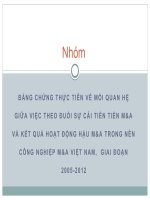

![gherghina et al - 2014 - a study on the relationship between cgr and company value - empirical evidence for s&p [cgs-iss]](https://media.store123doc.com/images/document/2015_01/02/medium_JKXoRwVO1T.jpg)
